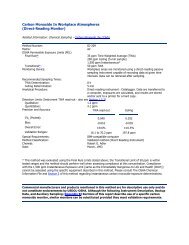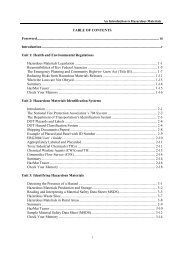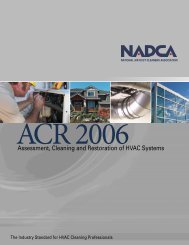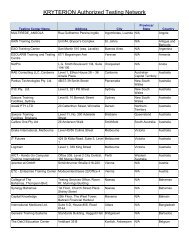Dampness and Mould - WHO guidelines for indoor air quality - PRWeb
Dampness and Mould - WHO guidelines for indoor air quality - PRWeb
Dampness and Mould - WHO guidelines for indoor air quality - PRWeb
Create successful ePaper yourself
Turn your PDF publications into a flip-book with our unique Google optimized e-Paper software.
XIII<br />
Health hazards result from a complex chain of events that link penetration<br />
of water <strong>indoor</strong>s, excessive moisture to biological growth, physical <strong>and</strong> chemical<br />
degradation, <strong>and</strong> emission of hazardous biological <strong>and</strong> chemical agents. The review<br />
of scientific evidence that supports these <strong>guidelines</strong> follows this sequence of<br />
events. The issues related to building dampness <strong>and</strong> its effect on <strong>indoor</strong> exposure<br />
to biological <strong>and</strong> non-biological pollutants are summarized in Chapter 2, which<br />
also addresses approaches to exposure assessment. An important determinant of<br />
dampness <strong>and</strong> biological growth in <strong>indoor</strong> spaces is ventilation, <strong>and</strong> this issue is<br />
discussed in Chapter 3. The evidence <strong>for</strong> the health effects of <strong>indoor</strong> exposure is<br />
presented in Chapter 4, based on a review of epidemiological studies <strong>and</strong> of clinical<br />
<strong>and</strong> toxicological research on the health effects of dampness <strong>and</strong> mould. The<br />
results of the epidemiological <strong>and</strong> toxicological studies are summarized in the<br />
appendices.<br />
The background material <strong>for</strong> the review was prepared by invited experts <strong>and</strong><br />
discussed at a <strong>WHO</strong> working group meeting, convened in Bonn, Germany, 17–<br />
18 October 2007. The conclusions of the working group discussion are presented<br />
in Chapter 5 <strong>and</strong> are reproduced in this executive summary, as follows.<br />
Sufficient epidemiological evidence is available from studies conducted in different<br />
countries <strong>and</strong> under different climatic conditions to show that the occupants<br />
of damp or mouldy buildings, both houses <strong>and</strong> public buildings, are at<br />
increased risk of respiratory symptoms, respiratory infections <strong>and</strong> exacerbation<br />
of asthma. Some evidence suggests increased risks of allergic rhinitis <strong>and</strong><br />
asthma. Although few intervention studies were available, their results show<br />
that remediation of dampness can reduce adverse health outcomes.<br />
There is clinical evidence that exposure to mould <strong>and</strong> other dampness-related<br />
microbial agents increases the risks of rare conditions, such as hypersensitivity<br />
pneumonitis, allergic alveolitis, chronic rhinosinusitis <strong>and</strong> allergic fungal<br />
sinusitis.<br />
Toxicological evidence obtained in vivo <strong>and</strong> in vitro supports these findings,<br />
showing the occurrence of diverse inflammatory <strong>and</strong> toxic responses after<br />
exposure to microorganisms isolated from damp buildings, including their<br />
spores, metabolites <strong>and</strong> components.<br />
While groups such as atopic <strong>and</strong> allergic people are particularly susceptible to<br />
biological <strong>and</strong> chemical agents in damp <strong>indoor</strong> environments, adverse health<br />
effects have also been found in nonatopic populations.<br />
The increasing prevalences of asthma <strong>and</strong> allergies in many countries increase<br />
the number of people susceptible to the effects of dampness <strong>and</strong> mould in<br />
buildings.






